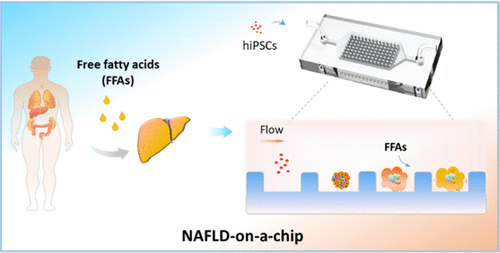当前位置:
X-MOL 学术
›
ACS Biomater. Sci. Eng.
›
论文详情
Our official English website, www.x-mol.net, welcomes your feedback! (Note: you will need to create a separate account there.)
Modeling Human Nonalcoholic Fatty Liver Disease (NAFLD) with an Organoids-on-a-Chip System
ACS Biomaterials Science & Engineering ( IF 5.8 ) Pub Date : 2020-09-16 , DOI: 10.1021/acsbiomaterials.0c00682 Yaqing Wang 1, 2, 3 , Hui Wang 2, 3 , Pengwei Deng 2, 3 , Tingting Tao 2, 3 , Haitao Liu 2, 3 , Shuo Wu 1 , Wenwen Chen 2, 3 , Jianhua Qin 2, 3, 4, 5
ACS Biomaterials Science & Engineering ( IF 5.8 ) Pub Date : 2020-09-16 , DOI: 10.1021/acsbiomaterials.0c00682 Yaqing Wang 1, 2, 3 , Hui Wang 2, 3 , Pengwei Deng 2, 3 , Tingting Tao 2, 3 , Haitao Liu 2, 3 , Shuo Wu 1 , Wenwen Chen 2, 3 , Jianhua Qin 2, 3, 4, 5
Affiliation

|
Nonalcoholic fatty liver disease (NAFLD) is a common metabolic and progressive disease, which has emerged as a major cause of chronic liver disease worldwide. It is characterized by the process ranging from simple steatosis to nonalcoholic steatohepatitis. However, a deep understanding of NAFLD progression remains challenging due to the lack of proper in vitro human disease models. In this work, we proposed a new strategy to establish a human NAFLD model based on a human-induced pluripotent stem cell (hiPSC)-derived liver organoids-on-a-chip system. This system allows us to characterize the pathological features of NAFLD in liver organoids by exposure to free fatty acids (FFAs) in perfused three-dimensional (3D) cultures during a prolonged period. Upon FFA induction, liver organoids exhibited lipid droplet formation and triglyceride accumulation. Moreover, they showed upregulated expressions of lipid metabolism-associated genes, indicating the abnormal lipid metabolic process in NAFLD. The FFA-exposed organoids also showed reactive oxygen species (ROS) production and elevated expression of various inflammatory cytokine genes and fibrogenic markers. These alterations represented the typical biochemical characteristics of NAFLD progression, which may provide insight into the potential mechanisms underlying steatosis. The proposed human NAFLD-on-a-chip model combines stem cell organoids with organs-on-chips, which may provide a promising platform for extending their applications for disease studies and effective therapies.
中文翻译:

使用类人生物芯片系统对人类非酒精性脂肪性肝病(NAFLD)建模
非酒精性脂肪肝疾病(NAFLD)是一种常见的代谢性和进行性疾病,已成为全球范围内慢性肝病的主要原因。其特点是从单纯性脂肪变性到非酒精性脂肪性肝炎。然而,由于缺乏适当的体外方法,对NAFLD进展的深入了解仍然具有挑战性人类疾病模型。在这项工作中,我们提出了一种新的策略来建立基于人类诱导的多能干细胞(hiPSC)衍生的单片肝类器官的人类NAFLD模型。该系统使我们能够通过长时间在灌注三维(3D)培养物中暴露于游离脂肪酸(FFA)来表征肝脏类器官中NAFLD的病理特征。FFA诱导后,肝类器官显示脂质滴形成和甘油三酸酯积累。此外,他们显示脂质代谢相关基因的表达上调,表明NAFLD中的脂质代谢过程异常。暴露于FFA的类器官还显示出活性氧(ROS)的产生以及各种炎症细胞因子基因和纤维化标记物的表达升高。这些改变代表了NAFLD进展的典型生化特征,这可能提供对脂肪变性潜在机制的深入了解。拟议的人类NAFLD芯片模型将干细胞类器官与芯片器官结合在一起,这可能为扩展其在疾病研究和有效疗法中的应用提供有希望的平台。
更新日期:2020-10-12
中文翻译:

使用类人生物芯片系统对人类非酒精性脂肪性肝病(NAFLD)建模
非酒精性脂肪肝疾病(NAFLD)是一种常见的代谢性和进行性疾病,已成为全球范围内慢性肝病的主要原因。其特点是从单纯性脂肪变性到非酒精性脂肪性肝炎。然而,由于缺乏适当的体外方法,对NAFLD进展的深入了解仍然具有挑战性人类疾病模型。在这项工作中,我们提出了一种新的策略来建立基于人类诱导的多能干细胞(hiPSC)衍生的单片肝类器官的人类NAFLD模型。该系统使我们能够通过长时间在灌注三维(3D)培养物中暴露于游离脂肪酸(FFA)来表征肝脏类器官中NAFLD的病理特征。FFA诱导后,肝类器官显示脂质滴形成和甘油三酸酯积累。此外,他们显示脂质代谢相关基因的表达上调,表明NAFLD中的脂质代谢过程异常。暴露于FFA的类器官还显示出活性氧(ROS)的产生以及各种炎症细胞因子基因和纤维化标记物的表达升高。这些改变代表了NAFLD进展的典型生化特征,这可能提供对脂肪变性潜在机制的深入了解。拟议的人类NAFLD芯片模型将干细胞类器官与芯片器官结合在一起,这可能为扩展其在疾病研究和有效疗法中的应用提供有希望的平台。



























 京公网安备 11010802027423号
京公网安备 11010802027423号